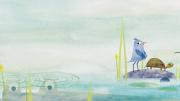 |
| Photograph courtesy of Harvard University Art Museums |
Vital, handsome, standing four-square, its tail raised, neck arched, head lifted, eyes bulging, and mouth open as if making notable remarks, this horse is important for reasons besides its good looks. First, it is large: four feet high from hoof to ear tip. According to Robert D. Mowry, Dworsky curator of Chinese art at the Arthur M. Sackler Museum, numerous equine sculptures of this type are known from Sichuan province in southwest China, but most measure half to three-quarters the size of this one. Second, it has a caramel-brown glaze over much of its body and in color may be unique. Most such horses are unglazed; the few glazed examples are of a degraded emerald green. The hollow piece is molded of brick-red earthenware except for the detachable ears, which are of gray clay. After firing, all the unglazed surfaces were coated with pigment, of which traces remain, and so the differing clay colors would not have been apparent. The horse was soon to disappear from view anyway, as it was made expressly for burial in a brick-walled, chambered tomb. (It galloped into the Sackler in 2004, a gift of R.H. Ellsworth, and may be seen through June 11 in the exhibition “Evocative Creatures: Animal Motifs and Symbols in East Asian Art.”) Third, the piece is in near perfect condition. Fourth, it is the only known horse from the Han dynastythis one being probably from the second century A.D.with decorative bridle medallions.
“The bridle sports five circular medallions, each boasting a human face at its center,” Mowry explains. “The number, placement, and decoration of the medallions accord exactly with Roman convention. The bridle thus stands as evidence of the early influence from the West that reached China via the Silk Route.”
The horse itself is of imported stock, an Arabian. Writing in From Court to Caravan: Chinese Tomb Sculptures from the Collection of Anthony M. Solomon, a 2002 exhibition catalog of objects later given to the Sackler, independent scholar Virginia L. Bower notes that the Emperor Wu, beginning in the second century B.C., “devoted vast resources to obtaining tianma, or ‘Heavenly Horses,’ from Central Asia.” They were much preferred to indigenous Mongolian ponies and were prized for their strength and endurance. Entombed, the mission of the aristocratic steed posing here was to transport the soul of the deceased to the next world.





